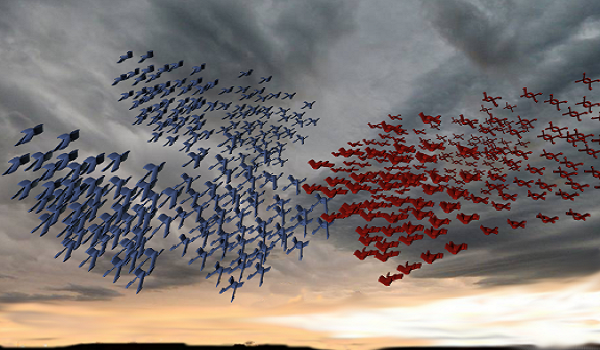BY LETTER
Nanoswarm
History > 0030 to 0900 AT: Solsys Era > 530 to 900 AT: The Sundering
Technology > Technology Levels > High Tech / Hitech
Technology > Technology Type or Material > Nanotech
Technology > Application > Spore Technology
Technology > Technology Levels > High Tech / Hitech
Technology > Technology Type or Material > Nanotech
Technology > Application > Spore Technology
 Image from Steve Bowers |
A nanoswarm, also known as goo, nanobot swarm, or simply a 'swarm', is a large number of nanobots or nanotech microbots acting in concert as a swarm entity. The same term is also used to cover any kind of large-scale disaster involving self-replicating nanotech devices, whether nanoswarms in the technological sense play a significant role in such a disaster or not.
As Technology
As a technological device, a nanoswarm is a mass of nanobots or nanotech microbots that acts together as an extended superorganism. Because they are too small and numerous to be controlled individually, such tiny bots are usually directed in swarms that have their effect through emergent effects; the swarm comprises an extended superbot, much as an insect or synsect swarm represents and extended superorganism. Primitive early nanoswarms were used for relatively simple tasks such as recycling or refining operations on specific materials in a limited set of circumstances and could not operate outside of very carefully controlled artificial environments. Modern nanoswarms are often much more robust and may be able to operate over a wide range of natural or artificial environments. They can rapidly take on or create multiple forms, absorb and use a range of energies, and create materials from a variety of natural or refined feed stocks. They work together to make much larger structures or bots on the mesoscale, macroscale, or even megascale, giving them an extraordinarily broad range of action. They are foundational to a typical mechosystem, with roles in resource extraction, construction, and communication. Such everyday miracles as the operation of a typical angelnet or the extended sensorium of transapient beings would be impossible without various forms of nanoswarm activity.Creating or managing multiple or complex interacting nanoswarms without encountering large numbers of unintended consequences requires transapient-grade intelligence or, alternatively, an extended period of trial and error by modosophont-grade organizations. As a result, nanoswarms in everyday use are from known carefully screened stock, used in specific combinations for a specific range of circumstances.
As a Disastrous Event
Misused or maliciously used nanoswarms are commonly identified with the so-called Technocalypse in Solsys that ended the Solsys Golden Age in the middle first millennium AT and nearly extinguished Terragen civilization, as well as with some events that actually did exterminate various xenosophont civilizations. While it is true that out-of-control or deliberately misused manufacturing and recycling nanoswarms and the various types of khaki goo deployed by terrorists and military forces did cause widespread devastation in Solsys at the time, reconstructions show that they were just one element, and not the most important one, in a much more extensive event that appears to have involved multiple failures of complexity management, some involving nanotech devices, especially those capable of self-replication, and some involving the failure or misapplication or hostile use of other technologies entirely, especially in the realm of information technology. None of this would have been so serious had it not also been intimately associated with a widespread cascading failure and collapse of mutual social and economic agreements. Devastating as they can be on a local scale, free-floating swarms of nanobots, especially the relatively simple primitive nanobots of the day, were not capable by themselves of posing an existential threat to Terragenkind. Likewise the nanoswarm events that extinguished some past xenosophonts and which have occasionally damaged or destroyed modosophont-led civilizations within the Terragen sphere have proved on examination to be much more complicated events. For this reason some experts, even as far back as the early post-Nanodisaster period, preferred alternative terms such as 'The Swarms' (recognizing the role of replicators), or 'The Technocalypse' (recognizing the role of complex interrelated technologies). Nevertheless the term 'Nanoswarms' with its implication of rampaging nanobots has remained widely used.Worlds where true nanoscale swarms were partly or wholly responsible for the destruction of a planetary biosphere include Bourgatov, Meerlinda (a xenoswarm) and Swallowflight.
However named, the threat of such events is very real, however, and for this reason surviving groups during the Solsys Dark Ages made very limited use of nanotech involving replicators. When the Dark Ages had ended the First Federation tightly regulated the use of nanotech, making it illegal for private citizens to own unregulated replicators. This only deepened the monopoly the megacorps and hyperturings had over nanotech, as well as the danger of unreliable pirate nano. Replicators were not made widely available until the late Consolidation Age and in many areas not until the Integration. Even today there are many polities that ban unregulated nanotech for fear of a nanoswarm event.
Related Articles
- Bourgatov
- Meerlinda Disaster, the
- Replication - Text by M. Alan Kazlev
The basic process of reproduction for information, whether biological, alife, nanological, memetic, or other; and the means by which genetic or instructional information is propagated. - Swallowflight
- Technocalypse
Appears in Topics
Development Notes
Text by Stephen Inniss and M. Alan Kazlev
original by M. Alan Kazlev
Initially published on 09 December 2001.
original by M. Alan Kazlev
Initially published on 09 December 2001.






